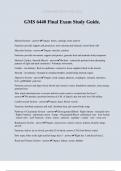©THEBRIGHTSTARS 2024
GMS 6440 Final Exam Study Guide.
Skeletal System - answer✔Organs: bones, cartilage, bone marrow
Function: provide support and protection, store calcium and minerals, form blood cells
Muscular System - answer✔Organs: muscles, tendons
Function: provide movement, support and protect, generate heat and maintain body temperate
Skeletal, Cardiac, Smooth Muscle - answer✔Skeletal - contractile proteins form alternating
patterns of light and dark (striations). Voluntary movement.
Cardiac - involuntary. Rich in capillaries, connective tissue supplies blood to the muscle
Smooth - involuntary. Grouped in irregular bundles, found lining internal organs.
Digestive System - answer✔Organs: teeth, tongue, pharynx, esophagus, stomach, intestines,
liver, gallbladder, pancreas
Function: process and digest food, absorb and conserve water, breakdown nutrients, store energy,
generate heat
How much intestinal juice is secrete and how much water is secreted into the feces? -
answer✔We produce anywhere between 6.5-8L of liquid a day but only lose 100 ml/day.
Cardiovascular System - answer✔Organs: heart, blood, vessels
Function: distribute nutrients and stuff, distribute heat and control body temp
Pathway of Circulatory System - answer✔Deoxygenated Blood - Right Atrium - tricuspid valve
- Right Ventricle - pulmonary artery - Lungs - Oxygenated Blood - pulmonary vein - Left Atrium
- mitral valve - Left Ventricle - Aorta - artery - arteriole - capillary - venule - vein - vena cava
Respiratory System - answer✔Organs: nasal cavity, sinuses, larynx, trachea, bronchi, lungs,
alveoli
Function: deliver air to alveoli, provide O2 to blood, remove CO2 from blood, sound
How many lobes to the right and left lungs have? - answer✔Right has 3 and the left has 2
Renal and Urinary System - answer✔Organs: kidney, ureter, bladder
, ©THEBRIGHTSTARS 2024
Function: excrete waste from blood, control water balance, storing urine, regulate blood [ ] and
pH
How much liquid do we filter a day and how much urine is usually produced? - answer✔We
filter 170 L/day while only producing 1.5 L of urine.
Endocrine System - answer✔Organs: pituitary gland, thyroid gland, pancreas, adrenal glands,
gonads, etc
Function: direct long-term changes in systems, metabolic activity, development
Major hormones and their functions - answer✔GH: pituitary. stimulates growth.
TH: thyroid. maintains metabolism, regulates BP, development
Cortisol: adrenal gland. Stress resistance and fat mobilization
Insulin: pancreas. Lowers blood sugar
Gastrin: stomach. Production of HCl
Erythropoietin: kidney. RBC production
Leptin: adipose. suppresses appetite.
Nervous System - answer✔Organs: Brain, spinal cord, peripheral nerves
Function: provide and interpret sensory info, coordinate activities of other systems
Female Reproductive System - answer✔Organs: ovaries, uterus, vagina, mammary glands
function: produce female sex cells, support embryo, provide milk
Menstrual cycle - answer✔ovulation occurs around 14 days into cycle when LH surge triggers
release of single mature egg from ovary to go through fallopian tubes to the uterus. If
unfertilized, it is discharged and endometrium is shed (menstruation).
Distribution of Major Electrolytes - answer✔Na+: 10:1 outside
K+: 25:1 inside
Cl-: 5:1 outside
HCO3-: 2:1 outside
Ca2+: micromolar inside. Thousand-fold greater outside.
Organic anions: 15:1 inside
channels vs transporters - answer✔channels move water or ions and electrode
transporters are solute carriers or pumps




